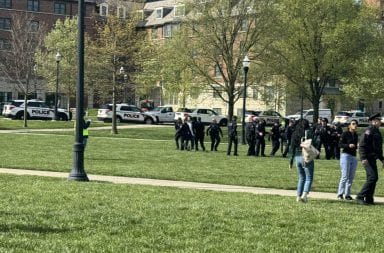April is considered to be one of the most deadly months for tornadoes and severe weather in Ohio, and students at Ohio State are warned to be prepared for the worst, as at least one Ohio city has been struck by a tornado this week.
Residents of the northeast Ohio town of Lowellville are cleaning up this week after a twister with winds up to 115 mph leveled garages and porches and ripped the roof off of one business. No injuries were reported, according to the National Weather Service.
“Tornadoes can strike anywhere at anytime and it could certainly happen on our campus, so students need to keep alert and be aware of what to do in the case of severe weather,” said Robert Barnett, coordinator of Housing and Food Service at OSU. “While these storms do come up quickly, it is usually enough time to take action,” he said.
To help the public better prepare for severe weather, the NWS has adopted a watch and warning program that helps to reduce the chance of weather-related injuries.
“A watch means that conditions are favorable for tornado development and this is what gives the university time to prepare for action. When a tornado has officially been sighted in the county they will issue a warning,” said Barnett.
Mark Byers, in the Food Agriculture and Environmental Sciences at OSU, also advocates student preparation during inclement weather as a way to avoid injury or death in the event of a tornado.
“The key to surviving any emergency, weather-related or otherwise, is pre-planning. Know your escape route and think about what you need to do beforehand. As the Boy Scouts say: Be prepared,” Byers said.
Steve Elliott, program director of the Office of Environmental Heath and Safety, said the Federal Emergency Management Agency has placed a number of tornado sirens on and around the OSU campus to notify students of danger.
According to the OEHS Web site, the Franklin County Outdoor siren warning system is one of the largest and most reliable systems in America.
The sirens are used primarily to warn of tornadoes and evacuations within the county. Each siren has a coverage area of about one mile. Most sirens are alarm- and voice-capable, and can be individually activated. Each siren is tested at least once a month on Wednesdays around noon, weather permitting.
“We utilize the sirens and the university police department procedure for severe weather cases,” Elliot said. “They have a 24-hour weather radio monitor which is the notification system for the campus, and then we act accordingly.”
“We suggest that in the event of severe weather, the safest place is in the university academic buildings. They are very well supported and reinforced by steel beams and concrete,” he said. “If you hear the sirens, take shelter on the lowest floor possible in a room that’s not an expansive one such as a gymnasium or auditorium,” Elliott said.
The emergency procedures established by University Police in case of a tornado warning is the sounding of emergency sirens for three minutes followed by seven minutes of silence until the warning expires. A warning indicates a tornado has been sighted by either ground observers or has appeared on radar within Franklin County.
Students are advised in the procedure that, if possible, they need to go to a ground level floor or a central hallway of the building that is clear of windows, mirrors, glass and any other unsecured objects such as filing cabinets or bookcases.
It is also important to remain in the safe area until at least 10 minutes have elapsed without the sounding of the sirens or the “all clear” signal has been given by officials.
According to the procedure, preplanning includes identifying the appropriate place in a building to seek shelter should a tornado occur.
An automobile is the most dangerous place to be, so one should not try to outrun a tornado. If traveling in a car when a tornado is sighted, exiting the car and seeking shelter is encouraged.
Barnett advises that because there is not a particular tornado alarm or PA system built into each hall, students living in the residence halls should be even more alert to bad weather conditions. Unlike fire drills, formal tornado drills are not conducted consistently, so students should take responsibility for their own safety and remain especially alert during peak tornado months, which are April through June in Ohio.
“We don’t call each individual student and we don’t have a public announcement system in the dorms, so it is the 24-hour service desk who calls all the halls to notify them of the emergency. Then they try to get the word out in the halls by means of resident assistants,” Barnett said.
The NWS Web site reports that no other country in the world has more tornadoes than the United States. In an average year 800 tornadoes are reported in the U.S., resulting in 80 deaths and more than1,500 injuries.


